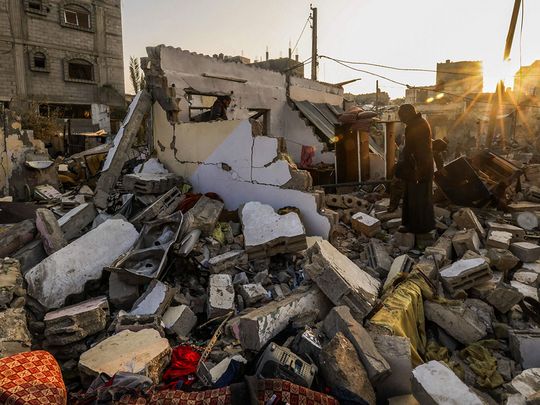
The Gaza conflict seems to be on the brink of a pivotal shift, with the emergence of a “blue map” outlining the potential endgame. This plan, which has been debated behind closed doors and, to some extent, in the public domain, involves a consensus among various parties, including Palestinian representatives (via Arab mediators), Israel, the US, and other Western nations.
The United Kingdom, well-acquainted with the Middle East, has hinted at a significant gesture of goodwill, with its foreign secretary David Cameron suggesting last week that it is considering recognising the state of Palestine.
This development comes amid various factors prompting the move towards a resolution, such as the exhaustion experienced by the conflicting parties, a Western political inclination to end the hostilities to prevent regional escalation, the dire situation of the Palestinian people in Gaza facing widespread devastation, and the desire to counteract regional powers looking to leverage the situation for their own ends. Additionally, there’s an intention to refocus attention on the larger conflict in Ukraine.
The proposed plan, as it has been leaked, involves a truce lasting two months or more, allowing for the release of hostages — slightly over 100 individuals — and a significant number of Palestinian prisoners from Israeli jails, prioritising the youngest, women, those with severe convictions, and the older prisoners.
Following this period, or as it draws to a close, Hamas’s military leadership and senior commanders would depart Gaza for a safe haven, likely in an Arab and geographically distant country. This part of the plan echoes the departure of Yasser Arafat from Lebanon, though on a different scale, and includes provisions to curb any political or other forms of Hamas activity in Gaza. The governance of the Strip would then transition to a joint administration, potentially including neighbouring Arab countries.
The final phase, following this transitional period, envisages the declaration of the state of Palestine, involving the West Bank and Gaza Strip, based on the Oslo Accords with certain amendments. This would be accompanied by broader Arab recognition of Israel.
Prolonged and devastating conflict
This blueprint for peace, the “blue map,” represents an initial framework, and transitioning to a fully actionable “white map” will require concerted effort. However, there’s a sense of optimism among the negotiating parties. The successful implementation of this plan could symbolise a mutual victory for most stakeholders involved in the conflict while undermining the ambitions of those who sought to exploit the turmoil for their own ends.
In the resolution’s aftermath, Palestinians would achieve a long-sought-after victory: a state recognised by the United Nations, emerging from a prolonged and devastating conflict that has impacted the entire region.
The plan effectively counters a grim concept that surfaced among some Israeli politicians at the conflict’s outset — the notion of “ethnic cleansing” by forcibly relocating Palestinians to the Sinai desert and the East Bank of the Jordan River.
This approach faced stiff resistance not only from Palestinian resistance movements but also from Egypt and Jordan, backed by Arab and international consensus, highlighting that such a displacement strategy is outdated, illogical, and unacceptable in the modern context.
In this critical election year in the US, the Biden administration is keen to avoid dragging the Gaza conflict into the presidential race as a dominant issue. A swift de-escalation or progression towards a resolution would eliminate a potential irritant from the US presidential campaign.
The Iran angle
Furthermore, a ceasefire agreement would wrest control of the conflict narrative in the Red Sea from the Houthis. Should they persist in their disruptive actions post-ceasefire, they would likely face global opposition from both the East and the West, and their ability to galvanise support through emotional appeal, fuelled by the ongoing war in Gaza, would diminish.
In Lebanon, Iran’s influence appeared to wane from the onset of the conflict, adhering to the “rules of engagement” to preserve Hezbollah’s military strength. Iran’s strategic priorities seem to focus on maintaining its sway over Lebanon and ensuring the majority of Syria remains under its influence, rather than the liberation of Palestine.
The situation is not as hopeful as some might think, given Iran’s awareness of the “blue map” and its specific details. This knowledge has spurred Iran into a time-sensitive competition, primarily driven by its ambition to expel international forces from Iraq. Iran aims to assert unparalleled influence over Iraq while also maintaining its sway in Syria and Yemen.
By sidelining the Palestine issue, Iran risks losing a crucial leverage point in its negotiations with Western adversaries, as well as diminishing its ability to rally Arab support for the Palestinian cause — a cause that has historically garnered widespread backing.
The recent attack by Iran-affiliated forces using a large drone on an American camp near the Jordanian-Syrian border, resulting in military casualties, was a strategic move to disrupt the status quo. Coupled with the ongoing escalations in recent weeks, these actions aim to delay or obstruct the transition of the “blue map” into a reality soon — a tactic not entirely unforeseen by the opposing side. This manoeuvring may be partially tolerated to achieve a broader objective: de-escalating the conflict.
This raises a pressing question: Will Hamas be willing to forgo its influence for a historic achievement for the Palestinian people, or will it cast doubts on the international community’s intentions?
This scepticism seems more plausible, aligning with the precedents set by past Palestinian leadership, who often intertwined their personal stature and influence with advancements for the cause.
Should the leaders, both those abroad and those commanding in conflict, choose this path, it would signify a colossal, missed opportunity for the entire Palestinian issue.
Mohammad Alrumaihi is an author and Professor of Political Sociology at Kuwait University











